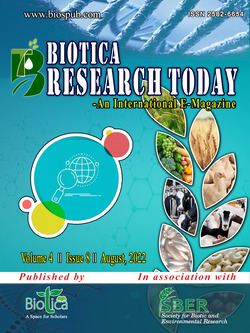
Smart Agriculture with IoT in Indian Farming
M. Uday Bhaskar*
Dept. of Agricultural Extension, S.V. Agricultural College, Tirupati, ANGRAU, Andhra Pradesh (517 502), India
N. Harisha
Dept. of Agricultural Extension, Sri Krishnadevaraya College of Agricultural Sciences, Anantapuram, Andhra Pradesh (515 002), India
M. Anantha Vihari
Krishi Vigyan Kendra (KVK), Rastakuntubai, Vizianagaram, ANGRAU, Andhra Pradesh (535 523), India
DOI: NIL
Keywords: Crop productivity, Internet of Things, Multi culture, Smart agriculture
Abstract
Agriculture farming began around 12000 years ago, with the Neolithic epoch giving birth to civilization, farming, and later being continued as traditional farming techniques. As an agrarian country, India's farming is heavily reliant on precipitation, soil, humidity, and environmental difficulties. Our farmers switched to cutting-edge agricultural technology. Globally, Internet of Things (IoT) systems have contributed to and shown to be successful in a variety of industries. It is now time for Indian farmers to implement Smart Agricultural Systems in order to increase crop productivity. Smart agriculture is a superior choice for increasing food output, managing resources, and labour. Internet of Things (IoT) devices with cloud administration, security units for multi culture in agriculture, and taking farmers' earlier experiences into account.
Downloads
not found
Reference
Gupta, L., Intwala, K., Khetwani, K., Hanamshet, T., Somkunwar, R., 2017. Smart Irrigation System and Plant Disease Detection. International Research Journal of Engineering and Technology 4(3), 80-83.
Ravindra, S., 2020. IOT Applications in Agriculture. Available at: https://www.iotforall.com/iot-applications-in-agriculture. Accessed on: 12th July, 2022.
Reddy, J., 2019. Role of AI and IoT in Agriculture: A full guide. Available at:https://www.agrifarming.in/role-of-ai-and-iot-in-agriculture-a-full-guide. Accessed on: 12th July, 2022.
Sahoo, J.P., 2020. Digital Farming - A New Era of Indian Agriculture. Biotica Research Today 2(7), 567-569.
